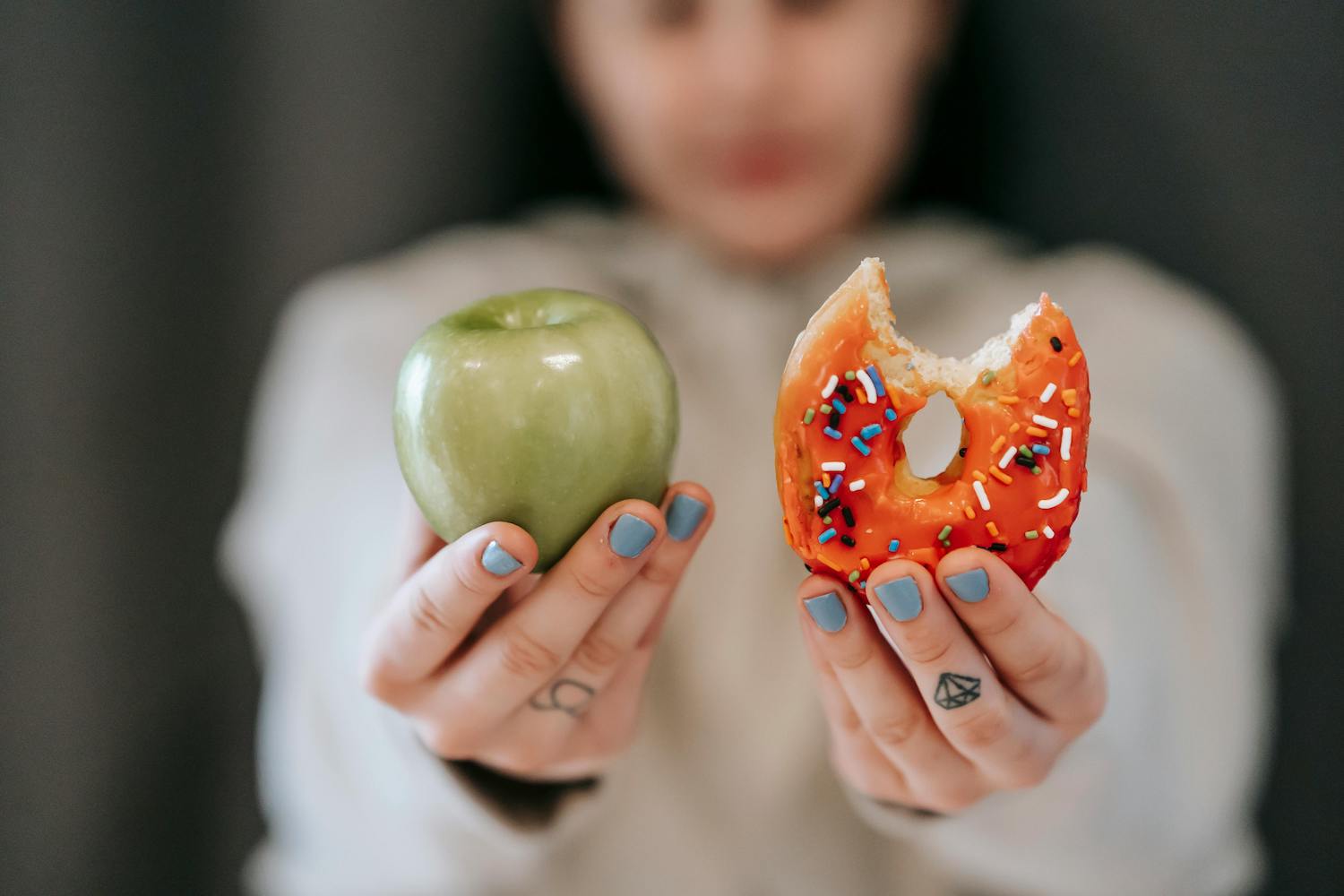It happened again. You were right on track with your health goals: smoothie in the morning, salad for lunch, Buddha bowl for dinner. Then, about 5 days in, you could feel the cravings growing stronger and stronger.
It’s as if they pushed you out of the driver’s seat and grabbed the wheel with both hands. Next thing you knew, you were eating the last cheese-coated popcorn at the bottom of the bag.
Cravings are powerful, and you’re not weak for giving in. In fact, trying to strong arm your cravings into submission often backfires and leads to more binging!
Today, I’ll teach you a different approach to taming your cravings. These five steps will decrease the frequency of cravings, reduce their strength, and healthily subdue them when they come.
Let’s jump in:
Step 1: Stop the Cravings Cycle
Cravings tempt us to eat unhealthy foods. But did you know that eating unhealthy foods also drives up our cravings? It’s a vicious cycle.
Take sugar, for example. Eating a lot of sugar causes your blood sugar to spike then crash. This rise and fall of blood sugar signals to our bodies that we need a high-sugar food to raise our blood sugar back up.
Then, add in the fact that, like drugs. Eating sugar activates dopamine levels (the “feel-good” hormone), making you crave sugary foods more and more.
Here’s the good news: The less you highly processed, sugary foods you eat, the smaller and smaller your cravings for those foods become. After some time, your body won’t want those foods anymore. If you do decide to enjoy some oreos with the kids or a bag of chips at a grill out, you’ll find yourself eating a few, then wanting a better food that satisfies both your taste buds and your body’s nutritional needs.
The Bottom Line: Recognize that beating craving takes time, but it gets way easier. Your cravings for highly processed and sugary foods will decrease, if you follow these next four tips.
Step 2: Don’t Cut, Swap
We needs a different view of cravings. Here’s the old school way of thinking about them:
I crave junk food that I shouldn’t eat. Sometimes I’m weak and give into those cravings.
This way of thinking leads to restrictive dieting, then binging.
There’s a much more scientific way of understanding cravings, and it helps us know how to work with them to keep moving forward in our health journey.
Think of it like this:
I crave junk food when my body is hungry, has low blood sugar, has a nutrient deficiency, is dehydrated, is stressed, or is sleep deprived.
Cravings are often a sign that our body has a need. That’s why trying to ignore your cravings backfires. Like a newborn, your body will cry louder and louder until it’s need is met.
Here’s Your Takeaway: Instead of trying to strongarm your cravings into submission, recognize that your body has a need. Meet its needs and your cravings will decrease. Which leads us to the third step…
Step 3: Eat More Protein and Fiber
Certain foods are particularly powerful at diminishing unhealthy cravings. Eating adequate protein and fiber is a non-negotiable for weight loss, overall health, hormonal balance, healthy aging, and reducing cravings.
Eating balanced meals that are high in protein and fiber will stabilize your blood sugar levels, keep you full for longer, and reducing sugar cravings. Foods like lean meats, beans, whole grains, fruits, and vegetables can help prevent energy dips that often trigger the desire for a quick sugar fix.
If you’re constantly reaching for cookies, candy, and desserts, grab a piece of fruit. Fruit tastes sweet but is loaded with filling fiber, vitamins, and minerals. They will help you reduce your cravings for sugar and meet your body’s nutritional needs all in one go! Berries, particularly, can help decrease sugar cravings and regulate blood sugar levels.
Do This: Start your day with a high-fiber breakfast that contains 40 grams of protein. For lunch and dinner, fill your plate with clean protein and lots of colorful produce, beans, whole grains, and healthy fats. Not sure where to start? Check out these recipes.
Step 4: Check Your Hydration
Dehydration can sometimes mimic hunger or cravings. Drinking enough water throughout the day not only helps reduce these cravings but also promotes better digestion, skin health, and overall well-being.
Try This: Make sure you’re drinking at least 8 cups of water a day, and if you’re feeling sluggish or reaching for unhealthy snacks, try sipping water first. Herbal teas or water with a splash of lemon are also great alternatives to sugary drinks and can offer a refreshing change without the added calories or sugar.
Step 5: Scale Up Sleep, Scale Down Stress
Lack of sleep and high stress levels are major contributors to unhealthy cravings. When you’re tired or stressed, your body craves quick energy from sugar or processed foods. Stress does the same, often prompting emotional eating. When we’re well-rested and relaxed, we have better control over our food choices and our cravings aren’t as intense.
Make This Your Goal: Prioritizing good sleep and practicing stress-management techniques like mindfulness, exercise, or deep breathing can make a huge difference in how your body handles cravings. Aim for 7-9 hours of sleep each night and incorporate relaxation practices into your routine to help reduce the physiological triggers that cause cravings.
Put Cravings Far Behind You
Breaking free from cravings can feel impossible, but after a few weeks, these five steps will help you regain control. By recognizing the root causes of your cravings and addressing them with practical habits—like eating a balanced diet, staying hydrated, managing stress, and getting enough sleep—your cravings will fade into the background of your health journey.
Overtime, you’ll find that your cravings become less frequent and much easier to manage. Remember, it’s not about being perfect, it’s about progress! Overwhelming cravings can be a thing of the past—just look at some of these stories and see how change is possible!





